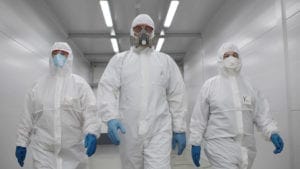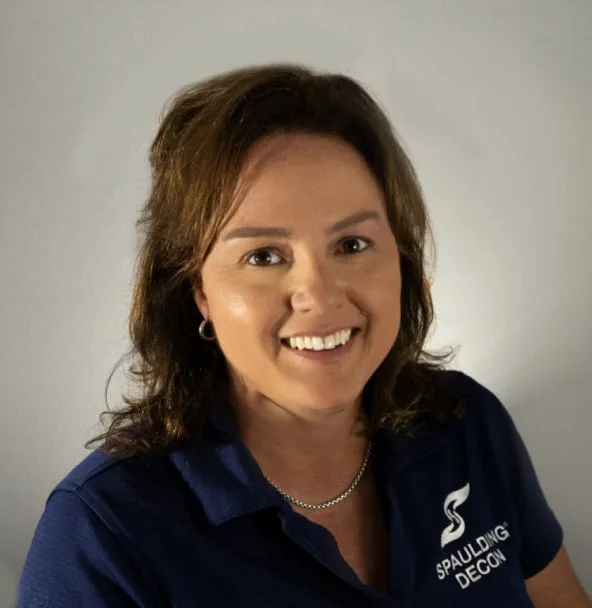Tear gas can refer to one of many types of chemical compounds. There are four main types of tear gas, Chlorobenzylidine malononitrile (CS), Chloroacetophenone (CN), Dibenzoxazepine (CR), and Oleoresin Capsicum (OC). The most common used by law enforcement for crowd control is CS. CN is sold as the person protectant , mace. OC is commonly referred to as pepper spray. Used as a riot control agent, tear gas is meant to disable a persons eye sight, respiratory system, and irritate the skin. Causing sneezing, coughing, and mucus membrane irritation, it renders and attacker harmless.
The residual effects of tear gas are just as dangerous as the initial use. Therefore, if tear gas is used inside a closed space, such as a building, storage unit, or home, it must be cleaned up properly before the space is again safe for habitation. When cleaning up tear gas residue, it can be If not cleaned properly, tear gas can cause upper respiratory problems, skin irritation and sinus issues. If possible, hiring a professional is the most effective way to safely remove tear gas residue, but if an attempt is going to be made without professional aid, a plan should be laid out and proper materials need to be purchased.

When cleaning any biohazardous materials the appropriate PPE is essential.
A plan should be laid out before beginning the removal of tear gas residue. If done wrong, the tear gas can become airborne again and spread. Mistakes in cleaning can cause the tear gas residue to become a larger cleanup than it already is which is why a plan is important. Many people do not have access to the tools that are needed for cleanup, but some equipment is essential. With the proper equipment, protection and solutions, it is possible to clean up the residue from tear gas. Below are the steps to ensure proper tear gas removal.
- What Type of Tear Gas Was Used?
Most common tear gasses used today are safe to clean up with the same conventional methods. If an older tear gas compound was used, some methods of cleanup that use heat can be dangerous. Contact your local law enforcement office for recommendations on cleanup.
- Use a HAZMAT Suit
Using a hazardous material (HAZMAT) suit, fitted with an air filtration mask is essential to protecting oneself when cleaning up tear gas. The suit will also cover your skin and eyes to prevent self-contamination. HAZMAT suits are regulated to be a safe form of protection when cleaning up hazardous material such as tear gas.
- Turn Off the HVAC System
If the heating, ventilation and air conditioning (HVAC) system running while cleaning, the residue can spread through the home and vents. If this happens the contamination will spread and the HVAC system will need to be cleaned which will require more money and professional help. Turning the system off will help contain the tear gas residue to the affected areas.
- Remove Items from the Affected Area
Setting up an area where the furniture and other items affected can be moved to and cleaned outside should be. Remove and dispose of carpet, and other porous materials (drapery, couches, etc.). If the dry wall was penetrated that will need to be removed and replaced as well.
- Vacuum
Vacuuming is an essential step because it can reduce the amount of loose residue before beginning deep cleaning. DO NOT USE A COMMERCIAL VACUUM. Standard vacuum cleaners allow the microscopic dust particles to flow into the air throw the filter and this will allow the tear gas residue to become airborne. Renting a high-efficiency particulate air (HEPA) or ultra- low penetration air (ULPA) vacuum is going to be the best option. The filters in these vacuums will keep the dust particles released into the air at a minimum.
- Spray and Wipe
Using an alkaline water solution or surfactant hard surface cleaner, spray down all the exposed surfaces. Follow up by wiping down the surfaces with a damp rag or mop. Avoid using brooms and brushes because they will stir up the tear gas residue and make it airborne again. Use this process on the items that were removed from the room as well.
- Repeat
Repeat steps 5 and 6 until the area and items are completely decontaminated. If possible, soaking items in the solution and allowing them to air dry will be most affecting in the removal of tear gas residue. Be sure this process is repeated until the room may be entered no residual effects are felt.
Contacting local the local law enforcement office for tips and tricks on cleaning up and removing tear gas residue is also a smart option when beginning cleanup. It is imperative to follow a safe cleanup procedure when tackling the removal of tear gas residue. Tear gas is a chemical weapon and should be treated as such. Always be sure to stick to a plan and when attempting the job without professional help.



